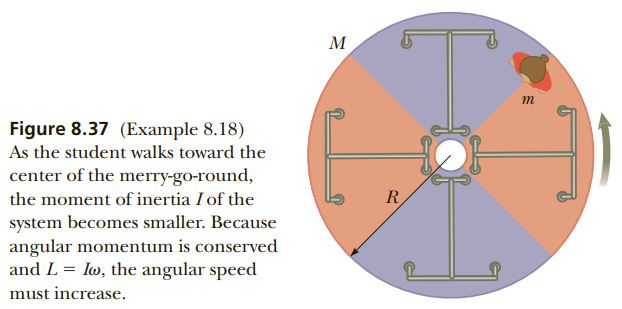Question 8.18: THE MERRY-GO-ROUND GOAL Apply conservation of angular moment...
THE MERRY-GO-ROUND
GOAL Apply conservation of angular momentum while combining two moments of inertia.
PROBLEM A merry-go-round modeled as a disk of mass M=1.00 \times 10^{2} \mathrm{~kg} and radius R=2.00 \mathrm{~m} is rotating in a horizontal plane about a frictionless vertical axle (Fig. 8.37 is an overhead view of the system). (a) After a student with mass m=60.0 \mathrm{~kg} jumps on the rim of the merry-go-round, the system’s angular speed decreases to 2.00 \mathrm{rad} / \mathrm{s}. If the student walks slowly from the edge toward the center, find the angular speed of the system when she reaches a point 0.500 \mathrm{~m} from the center. (b) Find the change in the system’s rotational kinetic energy caused by her movement to r=0.500 \mathrm{~m}. (c) Find the work done on the student as she walks to r=0.500 \mathrm{~m}.
STRATEGY This problem can be solved with conservation of angular momentum by equating the system’s initial angular momentum when the student stands at the rim to the angular momentum when the student has reached r=0.500 \mathrm{~m}. The key is to find the different moments of inertia.

Learn more on how we answer questions.
(a) Find the angular speed when the student reaches a point 0.500 \mathrm{~m} from the center.
Calculate the moment of inertia of the disk, I_{D} :
\begin{aligned}I_{D} &=\frac{1}{2} M R^{2}=\frac{1}{2}\left(1.00 \times 10^{2} \mathrm{~kg}\right)(2.00 \mathrm{~m})^{2} \\&=2.00 \times 10^{2} \mathrm{~kg} \cdot \mathrm{m}^{2}\end{aligned}
Calculate the initial moment of inertia of the student. This is the same as the moment of inertia of a mass a distance R from the axis:
I_{S i}=m R^{2}=(60.0 \mathrm{~kg})(2.00 \mathrm{~m})^{2}=2.40 \times 10^{2} \mathrm{~kg} \cdot \mathrm{m}^{2}
Sum the two moments of inertia and multiply by the initial angular speed to find L_{i}, the initial angular momentum of the system:
\begin{aligned}L_{i} &=\left(I_{D}+I_{S i}\right) \omega_{i} \\&=\left(2.00 \times 10^{2} \mathrm{~kg} \cdot \mathrm{m}^{2}+2.40 \times 10^{2} \mathrm{~kg} \cdot \mathrm{m}^{2}\right)(2.00 \mathrm{rad} / \mathrm{s}) \\&=8.80 \times 10^{2} \mathrm{~kg} \cdot \mathrm{m}^{2} / \mathrm{s}\end{aligned}
Calculate the student’s final moment of inertia, I_{S f}, when she is 0.500 \mathrm{~m} from the center:
I_{S f}=m r_{f}^{2}=(60.0 \mathrm{~kg})(0.50 \mathrm{~m})^{2}=15.0 \mathrm{~kg} \cdot \mathrm{m}^{2}
The moment of inertia of the platform is unchanged. Add it to the student’s final moment of inertia, and multiply by the unknown final angular speed to find L_{f} :
\begin{aligned}L_{f}=\left(I_{D}+I_{S f}\right) \omega_{f} &=\left(2.00 \times 10^{2} \mathrm{~kg} \cdot \mathrm{m}^{2}+15.0 \mathrm{~kg} \cdot \mathrm{m}^{2}\right) \omega_{f} \\&=\left(2.15 \times 10^{2} \mathrm{~kg} \cdot \mathrm{m}^{2}\right) \omega_{f}\end{aligned}
Equate the initial and final angular momenta and solve for the final angular speed of the system:
\begin{aligned}L_{i} &=L_{f} \\\left(8.80 \times 10^{2} \mathrm{~kg} \cdot \mathrm{m}^{2} / \mathrm{s}\right) &=\left(2.15 \times 10^{2} \mathrm{~kg} \cdot \mathrm{m}^{2}\right) \omega_{f} \\\omega_{f} &=4.09 \mathrm{rad} / \mathrm{s}\end{aligned}
(b) Find the change in the rotational kinetic energy of the system.
Calculate the initial kinetic energy of the system:
\begin{aligned}K E_{i} &=\frac{1}{2} I_{i} \omega_{i}{ }^{2}=\frac{1}{2}\left(4.40 \times 10^{2} \mathrm{~kg} \cdot \mathrm{m}^{2}\right)(2.00 \mathrm{rad} / \mathrm{s})^{2} \\&=8.80 \times 10^{2} \mathrm{~J}\end{aligned}
Calculate the final kinetic energy of the system:
K E_{f}=\frac{1}{2} I_{f} \omega_{f}^{2}=\frac{1}{2}\left(215 \mathrm{~kg} \cdot \mathrm{m}^{2}\right)(4.09 \mathrm{rad} / \mathrm{s})^{2}=1.80 \times 10^{3} \mathrm{~J}
Calculate the change in kinetic energy of the system:
K E_{f}-K E_{i}=920 \mathrm{~J}
(c) Find the work done on the student.
The student undergoes a change in kinetic energy that equals the work done on her. Apply the work-energy theorem:
\begin{aligned}W &=\Delta K E_{\text {student }}=\frac{1}{2} I_{S f} \omega_{f}^{2}-\frac{1}{2} I_{S i} \omega_{i}{ }^{2} \\&=\frac{1}{2}\left(15.0 \mathrm{~kg} \cdot \mathrm{m}^{2}\right)(4.09 \mathrm{rad} / \mathrm{s})^{2} \\&-\frac{1}{2}\left(2.40 \times 10^{2} \mathrm{~kg} \cdot \mathrm{m}^{2}\right)(2.00 \mathrm{rad} / \mathrm{s})^{2} \\W &=-355 \mathrm{~J}\end{aligned}
REMARKS The angular momentum is unchanged by internal forces; however, the kinetic energy increases because the student must perform positive work to walk toward the center of the platform.